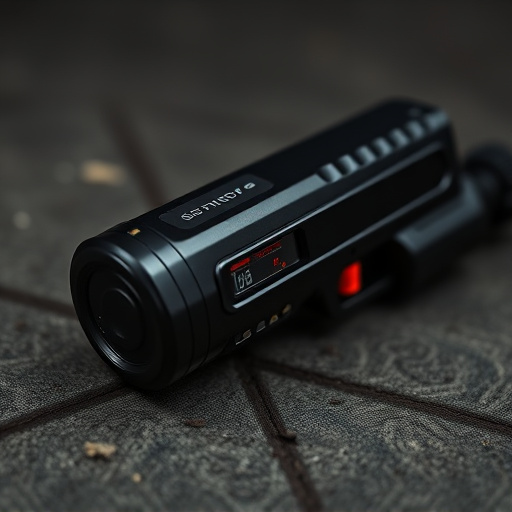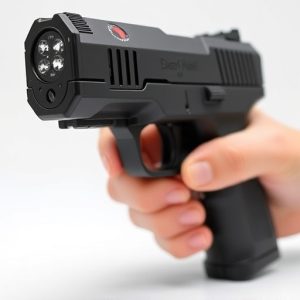Slider Stun Guns: Unlocking Advantages, Comparing Effectiveness, and Legal Considerations
Slider stun guns, a type of non-lethal projectile weapon, offer a safe, distance-based self-defense…….
Slider stun guns, a type of non-lethal projectile weapon, offer a safe, distance-based self-defense and law enforcement solution through kinetic impact. They have gained popularity due to their effectiveness in close-quarters situations and advanced technology. Key features like voltage output and slide mechanism design influence stun range and power. However, proper training and understanding legal regulations regarding age limits, hidden carry, and use scenarios are critical for safe and responsible use of slider stun guns or any stun weapon, including tasers.
In the realm of personal defense, stun weapons have emerged as powerful tools, offering a non-lethal option for self-protection. This article explores two prominent categories: projectile stun weapons and contact stun devices, with a special focus on slider stun guns. We’ll delve into their unique mechanisms, advantages, and the legal landscape surrounding them. Understanding these distinctions is crucial when choosing an effective yet safe self-defense solution.
- Understanding Projectile Stun Weapons: How They Work and Their Advantages
- The Rise of Contact Stun Devices: A Closer Look at their Effectiveness
- Comparing Slider Stun Guns: Unlocking the Features that Set Them Apart
- Legal Considerations and Safety Precautions for Both Weapon Types
Understanding Projectile Stun Weapons: How They Work and Their Advantages

Projectile stun weapons, such as slider stun guns, operate by launching a small, non-lethal projectile at high velocity towards a target. These devices use a combination of kinetic energy and specialized projectiles designed to temporarily incapacitate or disrupt an individual without causing permanent harm. When deployed, the projectile impacts the target, creating a strong force that disrupts nerve impulses in the body, leading to muscle spasm, disorientation, and temporary loss of consciousness.
The advantages of slider stun guns and similar projectile weapons are numerous. They offer a non-lethal alternative for self-defense, law enforcement, and military operations, providing an effective means of neutralizing threats while minimizing the risk of fatal injuries. Their range allows users to disable targets from a distance, making them ideal for situations where close quarter combat is not feasible or desirable. Additionally, these weapons are generally easier to use than contact stun devices, as they require less physical contact and can be deployed quickly, making them a popular choice for individuals seeking personal protection.
The Rise of Contact Stun Devices: A Closer Look at their Effectiveness

In recent years, there’s been a notable rise in the popularity and usage of contact stun devices, particularly the slider stun gun. This shift can be attributed to evolving law enforcement strategies and public safety concerns. Unlike traditional projectile weapons that rely on distance and impact, contact stun devices utilize electrical current to incapacitate targets, making them especially effective in close-quarters situations.
The effectiveness of these devices lies not only in their ability to render an opponent immobile but also in the non-lethal nature of their operation. This is particularly crucial in scenarios where excessive force could result in serious injury or death. Slider stun guns, with their advanced technology and compact design, offer a powerful yet controlled response, making them valuable tools for professionals charged with maintaining public order and protecting citizens.
Comparing Slider Stun Guns: Unlocking the Features that Set Them Apart

Slider stun guns represent a unique category within non-lethal self-defense weapons, offering both simplicity and power. When comparing different models, several key features set them apart. One of the primary distinctions lies in their stun capabilities, which are determined by factors like voltage output and pulse width. Higher voltage can deliver more intense shocks, ensuring effectiveness over longer ranges.
Additionally, slide mechanisms vary significantly. Some designs feature spring-loaded sliders, providing a swift and consistent activation process. Others incorporate advanced technologies like electric current regulation, aiming to optimize shock delivery and user safety. Build quality, grip design, and the inclusion of accessories like holsters or chargers also play crucial roles in determining the overall practicality and user experience.
Legal Considerations and Safety Precautions for Both Weapon Types

When considering stun weapons, whether projectile or contact-based like a slider stun gun, legal considerations and safety precautions are paramount. Each type has its own set of regulations and potential risks. For projectile stun devices, such as stun guns or tasers, laws vary widely by jurisdiction, focusing on issues like age restrictions, hidden carry prohibitions, and permitted use scenarios. Contact weapons, including sliders, often face regulations centered around reasonable force, self-defense rules, and restrictions on their use by civilians versus law enforcement.
Safety is a critical concern for any stun weapon user. Both projectile and contact types require users to undergo training and understand proper usage to avoid injuries. For contact weapons like sliders, this includes learning safe target areas, while with projectiles, it’s about understanding range, windage, and the potential for ricochets. Users must also be aware of de-escalation techniques, as excessive force can lead to severe consequences, especially in public spaces.
In exploring projectile and contact stun weapons, it’s evident that each has its unique strengths. Projectile weapons offer a non-lethal solution with a longer reach, while contact devices provide immediate incapacitation. The slider stun gun stands out as a versatile option, combining elements of both. However, regardless of choice, legal considerations and safety precautions are paramount to ensure responsible use. Understanding the intricacies of these weapons and their effects is crucial for making an informed decision, especially in today’s diverse legal landscape.


